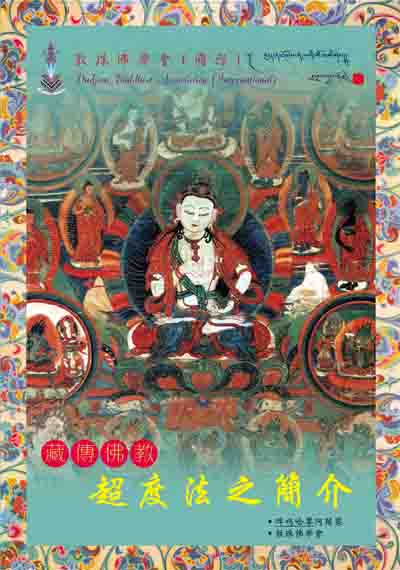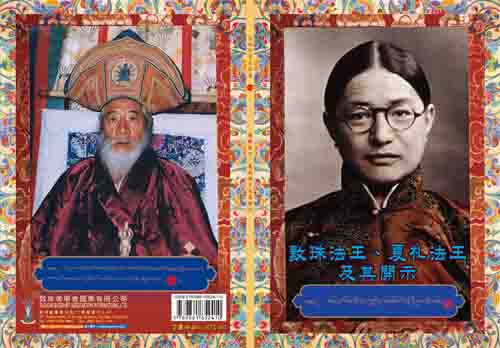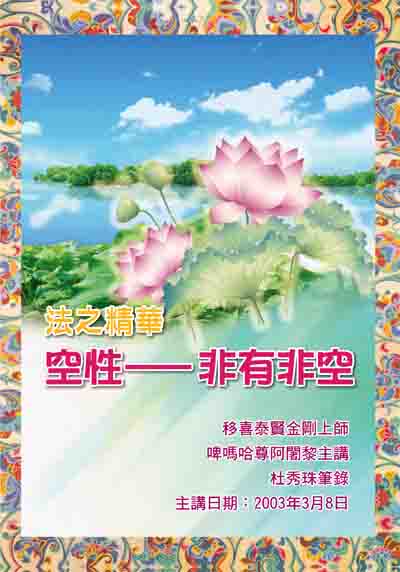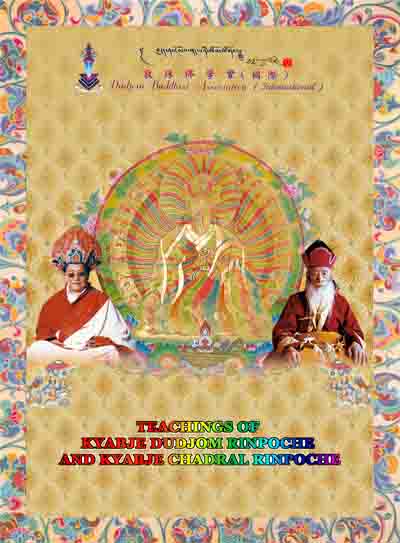If there is no positive and correct attitude to form its foundation,
thinking itself could be rather dangerous.
The thinker might allow himself to go astray by simply justifying
the means to achieve his/her end, and thus ending up in going beyond
the threshold of no return. For instance, in the practice of
Vajrayana, if a person merely concentrates on the format of practice
with an attitude of aiming for quick achievement, but disregards the
important direction of “mind-training”, then one's endeavors would
become in vain. Even worse, he/she might end up in a dangerous
situation.
In the selection of one’s own methods, a practitioner must need to
take into consideration his/her real practical circumstances. For
example, one must pay special attention to one’s own capability,
interest, expectation and all the costs that one is ready to pay
for.
One has to be faithful to one’s own ideal and to restrain oneself
from the desire “to flow with the tide”.
In order to reach the goal, one needs to upgrade and elevate one’s
own capability and to strive for it.
Indeed, to a
very great extent, both successes and
failures actually depend on whether one has the wisdom of knowing
“what to adopt and what to abandon”. In order to realize the
wisdom in question, certainly there are some methods that need to be
mastered.
The ancient
Chinese sage Zhuang Zhou had mentioned that “if onecan manage
one’s life well, then it would be possible for one tomanage one’s
death well”. If one can actively face the reality of life,realize it,
learn how to manage it, and eventually to master lifeskillfully
and light-heartedly, without further entanglements andendless
cycles of reincarnations, then this kind of
managing one’s life well is exactly the meaning of “the truth
of life”: that is, “knowing life” as
well as “knowing death”.
The
so-called “Dharma practice” is the one “true
practice” of “learning
how to handle life to the point that one will eventually be
able to master life light-heartedly”.
This book has made a “layer by layer”, and
yet profound, analysis of the wisdom within. Its viewpoint is not only
practical, but also up to the point and innovative. It can be applied in
our “daily living” and can also assist our “Dharma practice”.
Yet, flexibility and profundity have all been melted and integrated
together. The real cases that are listed in the book are most
inspiring. Even for ordinary people, if one
wants “not to fail to
live up to
this life, to make accomplishment, and to avoid wasting
time and run into snags and be foiled
everywhere”, this book is the first
choice, and it definitely would not let you down.
Contents
Chapter 1
1.1.
The Wisdom of Thinking
1.2.
“Direction” is Always More
Important Than “Speed”
Chapter 2
2.1. The Key Points
of Success and Failure
2.2. The Setting Up
of Objectives
2.3. Temporary
Objectives
2.4. Non-Thorough
Objectives
2.5. Long-Term
Objectives
2.6. A Most Thorough
Objective
Chapter 3
3.1. The Skills in the Setting-up of “Objectives”
3.2. Price to be Paid
3.3. Immediate Actions
Chapter 4
4.1. The Skills in
the Setting-up of “Plans”
4.2. Complementarity
and the Enhancement of Effectiveness
4.3. Wastages and
the Overlapping of Resources
4.4. Mutual
Impediments and Contradictions
Chapter 5
5.1. A thorough
Elimination Process to Decide on What to “Adopt and Abandon”
5.2. Designated
Elements and Conditions in Determining What to “Adopt and Abandon”
5.3.
Non-Differentiations on the “Order of Priority” Without the
Criterion of Importance
5.4. Mastering the
Practical Situations and Relevant Information in Relating to the
“Plan”
5.5. Avoiding
Outcomes That are Contradictory to the “Objectives”
5.6. Relying on
Logical Analysis and Not to Be Deceived by Illusions or Lies
5.7. The Three Steps
in Searching for an “Authentic Guru”
Chapter 6
6.1. This Life’s
“Combination of Resources” and Its Relations with “Destiny”
6.2. Where Did the
Money Come From?
6.3. History
Repeating Itself Again
6.4. Unexpected
Attacks
6.5. What Are the
Reasons Behind All These?
6.6. Criteria for
the Transmission of the Holy Dharma
6.7. The Wisdom in
Saving Oneself
Chapter 7
7.1. The “Leverage
on the Strengths to Launch an Attack” and The “Concealment of
Weaknesses from Being Attacked”
7.2. The Influences
of the Powers of “Mental Concentration” and of “Awareness” Within
the “Unconscious”
7.3. Getting More
Courageous as One Fights On and Getting Even Stronger When Meeting
the Strong Ones Heads-on
7.4. The Success and
Failure in the “Purification of Passions” and the “Attainment of
Buddhahood”
7.5. “Evading the
Serious Issues While Dwelling on the Trifles” and “Cultivating the
Strong Ones While Helping With the Weak Ones”
7.6. “Supernatural
Powers” Cannot Fight Against the “Law of Cause and Effect” (Karma)
Chapter 8
8.1. “The Planning
of Time” and “The Principles for Usages and Wastages of Time”
8.2. The Impact of
“Time” Upon Successes and Failures
8.3. Reasons for the
Distortion and Loss of the Buddhist Essence During Its Period of
Propagation
8.4. Conditions for
Dharma Practice in the “Dharma Semblance Age”
Chapter 9
9.1. “Planning of
Time” on the Path for Dharma Practice
9.2. Whole-life
Retreat
9.3. Long-term
Retreat
9.4. Three-Years
Retreat
9.5. Short-term
Retreat
9.6. The “Causes”
and “Effects” of Having “Dharma Practices” or Not
Chapter 10
10.1. In Daily
Living
10.2. The Three
“States of Mind” in “Mind-Training”
10.3. Merits and
Demerits of “Hinayana”
10.4. Merits and
Demerits of “Mahayana”
10.5. Merits and
Demerits of “Vajrayana”
10.6. The “Three
Essential Factors” in the Application of Buddhist Teachings in Our
“Daily Living”

.jpg)








%20big%205.jpg)


%20big%205.jpg)

































%20Engilish.jpg)
%20English%20cover%201a.jpg)

